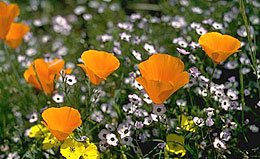Salinity Management Guide

About the difference the plant makes
Different types of plants vary considerably in their tolerances to the total amount of salt and to concentrations of sodium, chloride, and boron. For instance, turf grasses, most annuals, and deciduous plants typically tolerate more salt than evergreens do. Because they are frequently mowed, turf grasses do not normally accumulate high levels of salt. Also, they usually tolerate more sodium, chloride, and boron than other types of plants. Most annuals do not accumulate high levels of salt within their yearly life span. Many deciduous plants do not accumulate salt in their leaves, as they shed their leaves every autumn.

A salt-tolerant plant
Different species of plants also vary in their tolerance to total salt and to sodium, chloride, and boron. The more tolerant species are better able to adjust osmotically and to extract more water in the presence of a moderate to high amount of total salt and moderate to high concentrations of sodium, chloride, and boron. Examples of extremely tolerant plants include Alkali Sacaton grass, the Mexican Pinon pine tree, the Norfolk Island pine tree, Oleander, and Red Apple ice plant. All of these plants can tolerate 10 decisiemens per meter or more. When irrigated with such saline water, they require no more than a routine amount of management. If possible, choose a tolerant plant in the first place or replace a less tolerant plant with a more tolerant one.
| Sensitive | Moderately Sensitive | Moderately Tolerant | Tolerant |
|---|---|---|---|
| annual bluegrass | annual ryegrass | blue decaena | alkaligrass |
| colonial bentgrass | coast redwood | coast live oak | Bermuda grass |
| cotoneaster | cork oak | European fan palm | bougainvillea |
| crape myrtle | creeping bentgrass | forsythia | brush cherry |
| ginkgo | fine-leaf fescue | frangipani | Chinese tallow tree |
| Kentucky bluegrass | Italian cypress | oleander | croceum ice plant |
| liquidambar | Japanese boxwood | perennial ryegrass | evergreen pear |
| Oregon grape | orchid sage | rosemary | Mexican stone pine |
| photinia | southern magnolia | tall fescue | Norfolk Island pine |
| Pyrenees | xylosma | weeping bottlebrush | seashore paspalum |
| star jasmine | yellow sage | zoysiagrass | white/purple ice plant |

Young landscape plants or shrubs
For many plants, tolerance to salt or to sodium, chloride, or boron also varies, depending on the plant's stage of growth. Some plants are less tolerant when germinating and emerging and more tolerant when established and mature. Minimizing such a plant's exposure during the more sensitive stages of its life cycle may help to mitigate the effects of salt. Leaching salt from the intended root zone before planting is one way to do so. Another is to irrigate enough to prevent the soil from drying while the plant is becoming established. When a soil dries, salt may become concentrated closer to the plants' roots.
| « Previous page | Next page » |